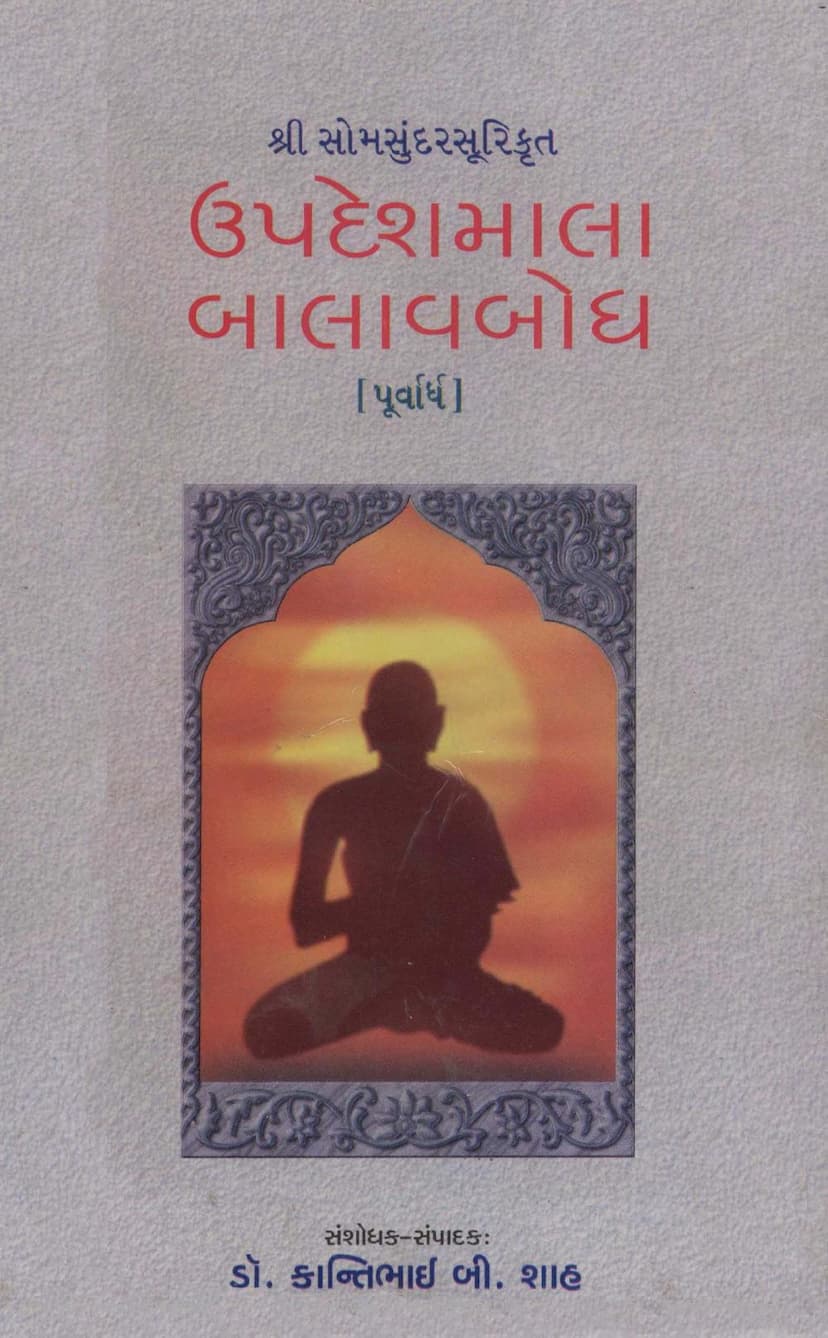Updeshmala Balavbodha Purvardha
Added to library: September 2, 2025

Summary
This document is the Purvardha (first part) of the Upadeshmala Balavbodh, authored by Shri Somsundarsuri, and researched and edited by Dr. Kantibhai B. Shah. It was published by the Saurashtra Kesari Pranguru Jain Philosophical and Literary Research Centre in Mumbai in 2001. The catalogue link provided is for the Jainqq.org exploration page.
Here's a comprehensive summary of the content based on the provided pages:
Core Identity of the Book:
- Title: Upadeshmala Balavbodh (Purvardha) - "Balavbodh" indicates a simplified explanation or commentary intended for understanding, often compared to teaching children.
- Original Work: Based on the Upadeshmala composed in Prakrit by Shri Dharmadasgali in the 6th century of the Veer Nirvana era.
- Author of Balavbodh: Shri Somsundarsuri, a prominent Acharya of the Tapa Gachchha lineage, who lived around VS 1430-1499. He is known for composing Balavbodhs for various important Jain texts.
- Researched and Edited by: Dr. Kantibhai B. Shah, a respected scholar in Jain literature.
- Publisher: Saurashtra Kesari Pranguru Jain Philosophical and Literary Research Centre, Mumbai. This center was established in memory of Saurashtrakesari Pranlalji Maharaj Saheb, with the aim of promoting Jain philosophy and literature.
- Content: The book contains the original gathas (verses) of the Upadeshmala, along with the Balavbodh (simplified commentary), a summary translation (sarannuvad), textual variants (pathantar), and a glossary (sarth shabdakosh). It covers 260 original gathas.
Content and Significance:
-
Purpose of Balavbodh: The Balavbodh form of literature was created by Jain Acharyas to make complex philosophical and ethical teachings accessible to those with a less developed understanding, akin to explaining to children. This specific Upadeshmala Balavbodh encapsulates the conduct and principles of monastic life (Sadhujiwan) and the duties of lay followers (Shravakachar).
-
Monastic Life (Sadhujiwan): The book details various aspects of a monk's life, including:
- Types of monks.
- Distinguishing true monks from those who are lax in their observances.
- Guru-disciple relationships.
- Characteristics of renunciate monks.
- Monastic diet and conduct.
- Adherence to vows and principles.
- The author uses illustrative stories of great souls to explain these points.
-
Lay Follower's Life (Shravakachar): It also explains the ideals for lay followers, such as:
- The difference between beings with lighter and heavier karma.
- The nature of attachment and aversion.
- The rarity and importance of human life.
- Forbidden foods (abhakshya) that a lay follower must abstain from.
- The principle of non-possession (parigraha tyag).
- Ideals of lay life.
- Vows (vrata).
- Righteous prosperity.
- Devotion to the guru.
- Concern for the welfare of the Jain tradition.
- Illustrative stories of ideal lay followers are used to convey these messages.
-
Illustrative Stories (Drushtantkathao): The text features 68 illustrative stories presented in simple Gujarati, following the commentary of each gatha. These stories are designed to be engaging and enhance the understanding of the religious teachings. The editor has also provided lists of these stories and subhashitas in appendices.
-
Subhashitas: The author, Shri Somsundarsuri, has incorporated 57 wise sayings (subhashitas) – 29 in Sanskrit and 28 in Prakrit – within the text, often introduced by phrases like "Thus it is said" (Tathā uktam or Uktam cha). Many of these are cited from existing scriptures like the Uttaradhyayan Sutra, Dashavaikalika Sutra, or Umaswami's Tattvartha Sutra.
-
Linguistic and Literary Value:
- The Balavbodh is considered important for studying medieval Gujarati prose.
- The language is described as simple, easy, and reflective of contemporary colloquial speech.
- The stories are praised for their ability to engage the reader's interest and lighten the dryness of religious teachings.
- The text provides insights into the vocabulary and linguistic features of Gujarati from 550 years ago.
-
Author's Background (Shri Somsundarsuri):
- Born in VS 1430 in Palanpur, belonged to the Porwad caste.
- Received initiation at the age of seven.
- Became a scholar at a young age, achieving the rank of Upadhyay at 20 (VS 1450) and Acharya at 27 (VS 1457) in Patan.
- Became the 50th pontiff of the Tapa Gachchha.
- He was known for his strict adherence to monastic discipline and his efforts to rectify laxity among monks.
- He was instrumental in initiating the process of copying palm-leaf manuscripts onto paper, preserving valuable Jain texts.
- He composed Balavbodhs for several key texts, including Upadeshmala, Bhaktamara Stotra, and Gautam Prachha.
- His period (VS 1450-1500) is referred to as the "Somsundar Yug" in Jain literature history due to his significant contributions to shaping medieval Gujarati prose and his role in preserving knowledge.
- He passed away around VS 1499 or later.
-
Editorial and Publication Efforts:
- The current publication is the result of Dr. Kantibhai B. Shah's research and editing, inspired by Acharya Shri Vijaypradhumansuriji.
- Dr. Shah utilized three key manuscripts for his work: one from VS 1499 (considered the primary text), one from VS 1527, and another from VS 1546.
- The publication was made possible by the financial support of various Jain trusts and organizations, notably the Matunga Jain Svetambara Murtipujak Tapgachh Sangh and Charities, Mumbai.
- The editor expresses his deep gratitude to the publishing center, its coordinator Gunvant Barvalia, and the institutions that provided the manuscripts. He also laments the passing of Shri Jayant Kothari, his guide in this endeavor.
Overall Purpose and Target Audience:
The book is intended to be useful for:
- The general public seeking inspiration for a virtuous and ethical life.
- Scholars interested in studying medieval Gujarati literature and prose.
- Students and curious individuals wishing to understand the various facets of Jain philosophy in depth.
- It is considered a "treasure book" for devout monks and pious lay followers.
In essence, "Upadeshmala Balavbodh (Purvardha)" is a scholarly critical edition of a significant medieval Gujarati Jain text, making the teachings of Shri Somsundarsuri accessible and understandable to a wider audience, thereby contributing to the preservation and dissemination of Jain wisdom.